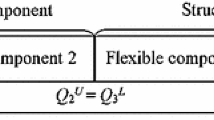Abstract
In this paper we consider a negotiation between a supplier and its retailer. Due to the supplier's commitments with other customers the negotiation is about the maximum order quantity the retailer can order at a fixed price. We propose a structuring for the negotiation that captures two main features: First, we take into account that the supplier can strategically change its production facilities. The impact of this strategic decision is captured by the corresponding change of the supplier's cost situation. Second, we consider the uncertainty about the retailer's future demand due to its own customers. The negotiation takes place with respect to different demand scenarios, yielding a variety of possibilities of avoiding negotiation deadlocks.
Similar content being viewed by others
References
Agrawal, N. and S. Nahmias (1997), “Rationalization of the Supplier Base in the Presence of Yield Uncertainty,” Production and Operations Management, 6(3), 291–308.
Banerjee, A. (1986), “A Joint Economic-Lot-Size Model for Purchaser and Vendors,” Decision Sciences, 17, 292–311.
Christopher, M. (1992), Logistics and Supply Chain Management. Strategies for Reducing Costs and Improving Services. Pitman, London.
Corbett, C.J. and X. de Groote (1997), “Integrated Supply-Chain Lot Sizing under Asymmetric Information,” in Proceedings of First Xavier de Groote Memorial Conference, INSEAD.
Goyal, S.K. and Y.P. Gupta (1989), “Integrated Inventory Models: The Buyer-Vendor Coordination,” European Journal of Operational Research, 41, 261–269.
Keeney, R.L. and H. Raiffa (1976), Decisions with Multiple Objectives: Preferences and Value Tradeoffs. John Wiley & Sons, New York.
Kohli, R. and H. Park (1989), “A Cooperative Game Theory Model of Quantity Discounts,” Management Science, 35(6), 693–707.
Monahan, J.P. (1984), “A Quantity Discount Pricing Model to Increase Vendor Profits,” Management Science, 30(6), 720–726.
Munson, C.L. and M.J. Rosenblatt (1998), “Theories and Realities of Quantity Discounts: An Exploratory Study,” Production and Operations Management, 7(4), 352–369.
Pesenti, R. (1995), “Hierarchical Resource Planning for Shipping Companies,” European Journal of Operational Research, 86, 91–102.
Schneeweiss, Ch. (1999), Hierarchies in Distributed Decision Making. Springer, Berlin.
Vidal, C.J. and M. Goetschalckx (1997), “Strategic Production-Distribution Models. A Critical Review with Emphasis on Global Supply Chain Models,” European Journal of Operational Research, 98, 1–18.
Wild, B. and Ch. Schneeweiss (1993), “Manpower Capacity Planning-A Hierarchical Approach,” International Journal of Production Economics, 30/31, 95–106.
Weng, Z.K. (1995), “Channel Coordination and Quantity Discounts,” Management Science, 41(9), 1509–1522.
Author information
Authors and Affiliations
Rights and permissions
About this article
Cite this article
Homburg, C., Schneeweiss, C. Negotiations Within Supply Chains. Computational & Mathematical Organization Theory 6, 47–59 (2000). https://doi.org/10.1023/A:1009673225809
Issue Date:
DOI: https://doi.org/10.1023/A:1009673225809




